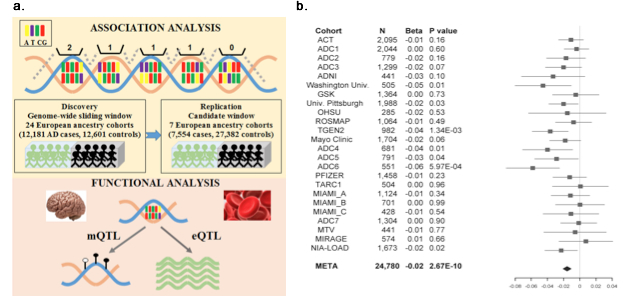Columbia University
Irving Medical Center
Neurological Institute
710 West 168th Street, 3rd floor
(212) 305-1818
TaubCONNECT Research Perspectives:
May 2019
2: » MFN2 Mutations in CharcotāMarieāTooth Disease Alter Mitochondria-Associated ER Membrane Function but Do Not Impair Bioenergetics
» #1 Association of Variants in PINX1 and TREM2 With Late-Onset Alzheimer Disease
» #2 Brain Biomarkers and Cognition Across Adulthood
» #2 Brain Arterial Dilatation and the Risk of Alzheimer's Disease
» #2 FDG-PET Patterns Associated with Underlying Pathology in Corticobasal Syndrome
» #1 Effect of Aerobic Exercise on Cognition in Younger Adults: A Randomized Clinical Trial
» #1 A Tau Homeostasis Signature Is Linked with the Cellular and Regional Vulnerability of Excitatory Neurons to Tau Pathology
» #2 Between-network Functional Connectivity Is Modified by Age and Cognitive Task Domain
» #2 Semantic Network Function Captured by Word Frequency in Nondemented APOE Īµ4 Carriers
» First Place: NSUN2 is Dysregulated in Alzheimer's Disease
» #1 Homeostatic Plasticity Scales Dendritic Spine Volumes and Changes the Threshold and Specificity of Hebbian Plasticity
» #2 An MRI Measure of Degenerative and Cerebrovascular Pathology in Alzheimer Disease
» #1 A Multi-Omic Atlas of the Human Frontal Cortex for Aging and Alzheimer's Disease Research
» #2 Whole-exome Sequencing in 20,197 Persons for Rare Variants in Alzheimer's Disease
» #2 Preparation of Tau Oligomers After the Protein Extraction from Bacteria and Brain Cortices
» #2 Medical Retirement from Sport after Concussions: A Practical Guide for a Difficult Discussion
» #1 Cross Domain Self-Monitoring in Anosognosia for Memory Loss in Alzheimer's Disease
» #2 White Matter Changes in Alzheimer's Disease: A Focus on Myelin and Oligodendrocytes
» #1 ZCCHC17 is a Master Regulator of Synaptic Gene Expression in Alzheimer's Disease
» #2 Imaging Translocator Protein as a Biomarker of Neuroinflammation in Dementia
» #3 A Transcriptomic Atlas of Aged Human Microglia
» #1 Neuronal Lysosomal Dysfunction Releases Exosomes Harboring APP C-terminal Fragments and Unique Lipid Signatures
 |  |  | ||
| Yiyi Ma, MD, PhD | Philip L. De Jager, MD, PhD | Richard Mayeux, MD, MSc |
Epigenetic effects such as DNA methylation have been reported in Alzheimerās disease (AD). DNA methylation associated with genetic variation occurs because of the attachment of a methyl group directly to a DNA nucleotide, specifically dinucleotide comprised of cytosine and guanine (CpG). CpG-related single nucleotide polymorphism (CGS) alter the sequence of the primary target sites for DNA methylation and account for a significant fraction (38% to 88%) of allele-specific methylation regions in the human genome. The combined effect of multiple nearby CGSes may play a unique role in AD. For example, the two single nucleotide polymorphisms (SNPs) encoding different APOE isoforms, the strongest genetic risk variants for AD, are CGSes and the number of CpG sites on the two chromatids is genotype dependent. Thus, APOE Īµ2/Īµ2, Īµ3/Īµ3, and Īµ4/Īµ4 homozygotes have 0, 1 and 2 CpG sites, respectively.
Dr. Yiyi Ma, along with Taub faculty members Drs. Philip De Jager, Richard Mayeux, and colleagues, conducted the first and largest region-based, CGS-focused, sliding window approach to measure the combined effects of multiple CGSes on AD risk in a discovery sample of 24 European ancestry cohorts (12,181 cases, 12,601 controls) from the Alzheimer's Disease Genetics Consortium (ADGC) and replication sample of seven European ancestry cohorts (7,554 cases, 27,382 controls) from the International Genomics of Alzheimer's Project (IGAP). The potential functional relevance of significant associations was evaluated by analysis of methylation and expression levels in brain tissue from the Religious Orders Study and the Rush Memory and Aging Project (ROSMAP), and in whole blood from Framingham Heart Study participants (FHS).
 Figure. a, Graphical abstract of the study. b, Forest plot of dose-response effect of the number of CpG dinucleotides created by the CGSes in the intergenic window close to MS4A4A on the logged odds ratio of AD. The filled square and horizontal line for each population or the filled diamond for the summary denote the estimated logged odds ratio and its 95% CI per unit increase in the number of CpG dinucleotides in the window.
|
Results of the study were published in Aging Cell, where the authors identified windows at BIN1, MS4A6A, MS4A4A, PICALM, and APOE. The total number of CGS-derived CpG dinucleotides in the window near MS4A4A was associated with AD risk, brain DNA methylation, and gene expression in brain and blood. Pathway analysis of the genes responsive to changes in the methylation quantitative trait locus signal at MS4A4A (cg14750746) showed an enrichment of methyltransferase functions. Herein, Ma et al. confirm the importance of CGS in AD and the potential for creating a functional CpG dosage-derived genetic score to predict AD risk.
Yiyi Ma, MD, PhD
Postdoctoral Research Scientist
Multiple Sclerosis Clinical Care and Research Center
Center for Translational & Computational Neuroimmunology
ym2666@cumc.columbia.edu
Philip L. De Jager, MD, PhD
Weil-Granat Professor of Neurology (in Neurology, the Taub Institute for Research on Alzheimer's Disease and the Aging Brain and the Precision Medicine Initiative)
pld2115@cumc.columbia.edu
 |  | |
| Delfina Larrea, PhD | Eric A. Schon, PhD |
CharcotāMarieāTooth disease type 2A (CMT2A) is a form of peripheral neuropathy, due almost exclusively to dominant mutations in the nuclear gene encoding the mitochondrial protein mitofusin-2 (MFN2). Clinically, patients exhibit progressive sensory loss in the extremities and pes cavus, among other features, with the disease presenting as early- or late-onset forms. Approximately 100 pathogenic mutations in MFN2 have been described, but there is no understanding of the relationship of clinical phenotype to genotype.
MFN2 has two functions: it promotes inter-mitochondrial fusion and mediates endoplasmic reticulum (ER)āmitochondrial tethering at mitochondria-associated ER membranes (MAM). MAM regulates a number of key cellular functions, including lipid and calcium homeostasis, and mitochondrial behavior.
 Figure 10: Working model of pathogenesis in CMT2AMFN2. The severity of the disease may be related to the degree of ERāmitochondrial communication.
|
However, the mechanism underlying the pathogenesis of CMT2A has been elusive. One question has been the role of mitochondria in the pathogenic process, rendering confounding results probably by the approach selected such as MFN2 overexpression. This is especially problematic when dealing with a dominantly inherited disorder in which both wild-type (WT) and mutant alleles are expressed, and whose equilibrium may be important in determining pathogenesis. Due to the role of MFN2 in MAM-mediated ERāmitochondria interactions, Taub faculty member Dr. Eric Schon, along with first author Delfina Larrea, Marta Pera, Orhan Akman, Estela Area-Gomez, Cristina Guardia-Laguarta, Kevin Velasco and colleagues, asked if MFN2 mutants have altered ER-mitochondria interactions and MAM functions.
As recently published in Human Molecular Genetics, using fibroblasts from three CMT2AMFN2 patients with different mutations in MFN2, Larrea et al. found that some, but not all, examined aspects of ERāmitochondrial connectivity and of MAM function were indeed altered, and correlated with disease severity. They also found that the respiratory chain function in those cells was unimpaired.
The results of this work suggest that CMT2AMFN2 is a MAM-related disorder but is not a respiratory chain-deficiency disease. The alterations in MAM function described here could also provide insight into the pathogenesis of other forms of CMT.
Delfina Larrea, PhD
Associate Research Scientist in the Department of Neurology
dl2777@cumc.columbia.edu
Eric A. Schon, PhD
Lewis P. Rowland Professor of Neurology (in Genetics and Development)
eas3@cumc.columbia.edu

